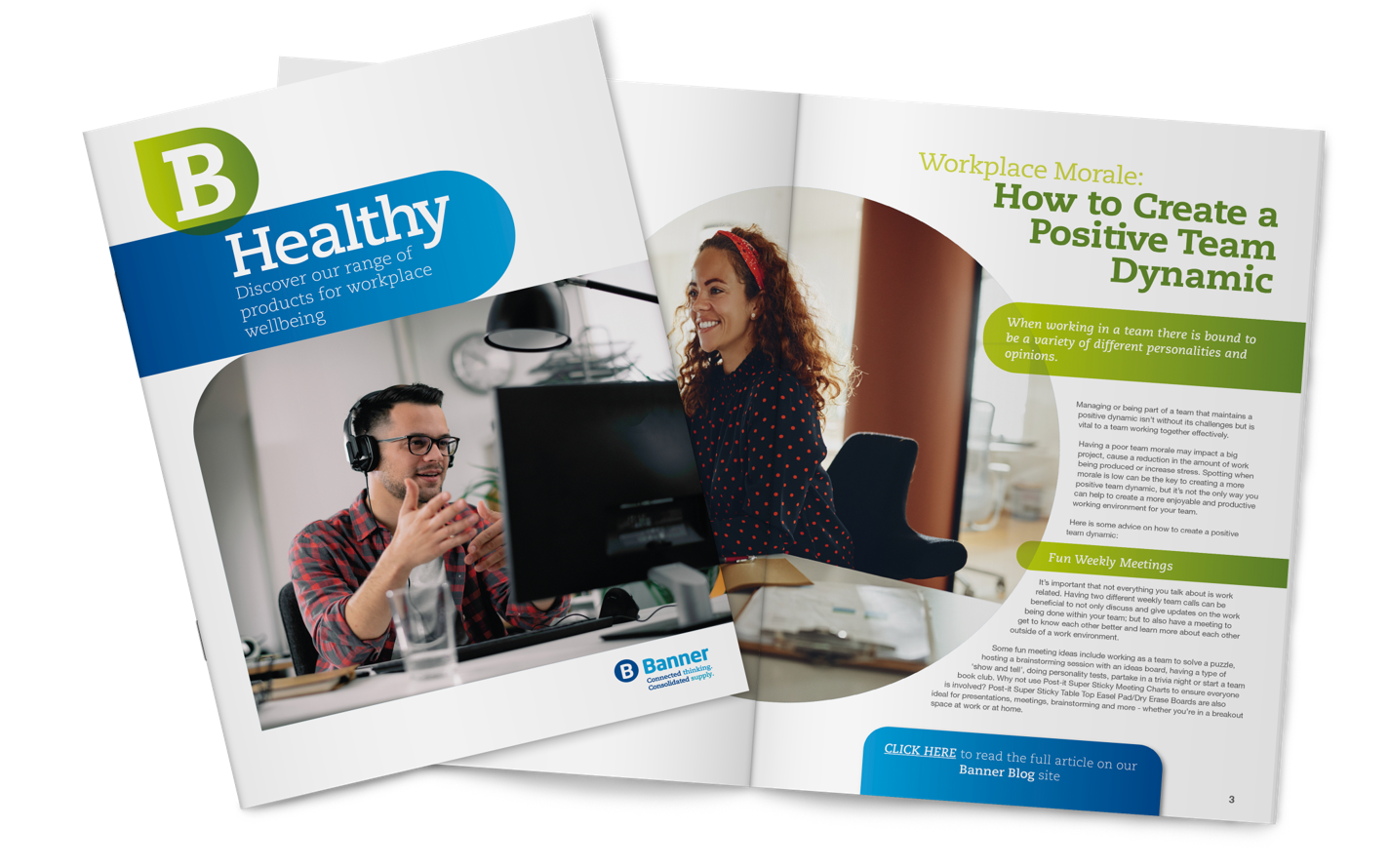
Health has different interpretations for us all. For some, what springs to mind first is physical health, perhaps the more traditional sense of the word. But more recently, advocation for mental health and well-being has been a key focus for many businesses, and a topic spoken about widely in the media and beyond.
As an employer, it’s important to create and maintain a workplace that encourages positive physical and mental health habits. A work environment that promotes health is essential within business, and will likely result in happier employees, lower absence rates, and better all-round well-being.
To help with both of these, we’ve put together five easy tips to help you make positive, and effective, changes.
1. Provide healthy food options
I think nearly all of us will admit to being guilty of taking a few too many trips to the work vending machine on the hunt for crisps, chocolate or sweets; and in moderation these food choices are okay! But frequent snacking on processed foods and drinks that have high sugar, salt and fat contents will ultimately have a negative impact on health, and may even cause employees to feel lethargic and sluggish.
Think about the ways that you, as an employer, can encourage healthier food and drink choices whilst at work. Having readily-available healthy snack options will give employees alternatives to the usual sugary, salty, processed snacks; and ensuring they’re competitively priced to these types of foods is essential. Offering free fruit in kitchen or canteen spaces will also encourage healthy snacking.
2. Enrich the senses
Sound: Preferred working conditions can differ immensely amongst individuals. Some people like the noise and buzz of a busy office, and are used to music, phones ringing, and constant conversation. Others prefer a quieter setting, with little to no distraction. It’s about finding a middle ground and providing options that suit everyone.
For example, if your office is a busy sales floor it’s important to provide quiet break-out areas where employees can go to focus on individual tasks which perhaps require more attention.
On the other hand, if your office is on the quieter side with few employees, simple things like having the radio on, set to a low volume, and allowing employees to listen to their own music or podcasts via headphones will likely improve mental stimulation, concentration, and overall well-being ¹ ² ³. Don’t be afraid of letting employees choose their own auditory stimulation, something as simple as playing music can increase dopamine levels, leading to improved mood which is likely to result in higher productivity.
Sight: Natural light in the workplace has a proven positive impact on employee health and well-being, and where possible and appropriate should be used as the main source of lighting in an office. Employees working in an office with optimised natural light experienced a 51% reduction in eyestrain, a 63% reduction in headaches, and a 56% reduction in drowsiness ¹ ². Studies have found that optimising the amount of natural light in an office significantly improves health and wellness amongst employees, leading to gains in productivity. “As companies increasingly look to empower their employees to work better and be healthier, it is clear that placing them in office spaces with optimal natural light should be one of their first considerations.“ ¹.
Even small, inexpensive changes such as including plants as part of your office decor can improve mental health and well-being by lowering anxiety and stress, improving concentration, and stimulating creativity ¹.
Never underestimate the impact that the work environment has on employees’ health. Which leads us nicely on to tip number three ¦
3. Improve the comfort
The workplace environment is an important source of job satisfaction, and can critically impact work motivation, job satisfaction, and physical and mental health ¹.
Uncomfortable furniture will likely lead to bad posture, stiffness, and pains and strains associated with office-style, inactive, desk-bound work. These complaints are a distraction that many businesses can’t afford their employees to have, and there is a danger that they could develop into more serious and permanent health problems.
However, careful consideration of the best way to maximise your office space, such as including comfortable and supportive furniture, can reduce the likelihood of developing these physical ailments. The ideal office chair will offer proper support to all areas of the body, facilitating movement whilst helping to prevent musculoskeletal disorders. Ultimately, good office furniture can boost employee performance by allowing people to concentrate on their tasks without distraction. ¹.
Every work station within an office environment should be assessed in order to reduce the number of risks involved. A DSE assessment involves assessing the risk involved with using screens in a work environment, for example back pain and neck strain from bad posture, and headaches and eyestrain caused by looking at a screen for too long. The goal of this assessment is to identify these risks, and take action to reduce them ¹. Request a DSE assessment with Banner, here.
For employees to perform at their very best, the workplace must be well-equipped for purpose, for example creating collaboration and concentration areas away from the main hustle and bustle of the office, and furniture plays an important role in creating these environments. Investing in ergonomic furniture that promotes healthy habits (e.g. standing desks) provides employees with the freedom to decide how they work best. There are numerous benefits of including ergonomics in the workplace, including increased productivity, better quality of work, healthier employees, reduced costs, and higher employee satisfaction and retention ¹.
Think about how the furniture placement around the workspace could encourage movement throughout the area. It’s also worth considering how breakout areas could encourage physical activity, such as table tennis, or a visually pleasing area for colleagues to walk around while on a break, or during a phone call.
4. Build and encourage a supportive culture
Employees spend a significant amount of time at work, whether this is in the office or elsewhere. It’s only human that there will be occasions where personal lives will interfere with work. By having established, strong, supportive relationships amongst employees within the business, you can help your colleagues deal with their situation, if they need it. Sometimes just knowing that there are people to go to, that the door is open, can make a world of difference.
Having your work culture built on a foundation of trust, honesty, openness, and non-judgement will ultimately result in a happier and healthier work environment.

Mental Health First Aiders
It would benefit your business to have at least one Mental Health First Aider per location. These people are normal, approachable employees who have an interest in mental health and your employees well-being.
What do they do?
From the MHFA (Mental Health First Aid) training, they are able to spot the signs of mental illness and step in to support a person who may need assistance. They will have and be taught skills to have a non-judgmental, private, and confidential conversation, to recognise the signs and symptoms of common mental health issues, and to effectively guide a person find the right support they need.
5. Promote a positive work-life balance
Promoting a healthy work-life balance is essential for a happy and healthy workplace ¹ ².
Encourage this by ensuring that, unless in exceptional circumstances, work is left behind at the office and employees aren’t far exceeding their contracted hours. Encourage time off, holidays, and allow for flexible working where possible. Allowing these policies will not only improve work-life balance, but will also mean employees feel more valued, knowing that their employer considers their needs and cares about this healthy balance.
All of this leads to overall better mental health, physical health, and well-being which can improve productivity, motivation, and performance at work. It will also likely improve overall job satisfaction therefore reducing staff turnover rates.
Imagine the reverse. Poor mental well-being directly affecting employees productivity, behaviour, and commitment to work. A government report on work-related stress revealed that stress accounted for nearly half of all working days lost because of ill health. Therefore it is not only in the employees interest, but also in the employers interest, to ensure employees are experiencing a good work-life balance ¹.
Businesses also reap the benefits from work-life balance culture, including increased employee retention and loyalty, improved employee motivation, morale, and commitment to their work and reduced absences ¹.
B Healthy
Discover our range of products for workplace well-being.
Packed with helpful tips and advice on how to stay healthy at work; as well as advice on how to elevate workplace hygiene.
Featuring a range of products for workplace well-being:
- Ergonomics
- Headsets
- Cleaning & hygiene
- Healthy hydration
Click here to view Banner’s B Healthy brochure.
Procurement Insights: For more insights join Banner on LinkedIn or follow us on Twitter.

